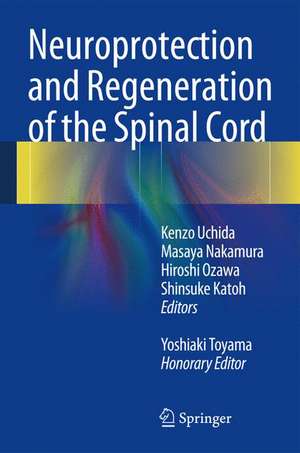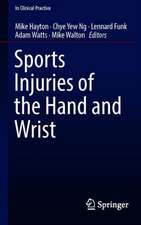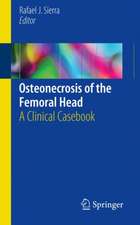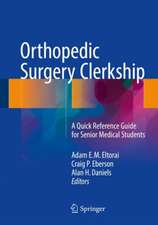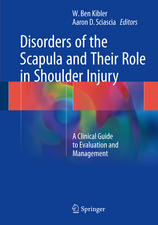Neuroprotection and Regeneration of the Spinal Cord
Editat de Kenzo Uchida, Masaya Nakamura, Hiroshi Ozawa, Shinsuke Katoh, Yoshiaki Toyamaen Limba Engleză Hardback – 17 mar 2014
| Toate formatele și edițiile | Preț | Express |
|---|---|---|
| Paperback (1) | 994.43 lei 38-44 zile | |
| Springer – 2 sep 2016 | 994.43 lei 38-44 zile | |
| Hardback (1) | 1116.21 lei 43-57 zile | |
| Springer – 17 mar 2014 | 1116.21 lei 43-57 zile |
Preț: 1116.21 lei
Preț vechi: 1174.96 lei
-5% Nou
Puncte Express: 1674
Preț estimativ în valută:
213.58€ • 223.60$ • 176.73£
213.58€ • 223.60$ • 176.73£
Carte tipărită la comandă
Livrare economică 07-21 aprilie
Preluare comenzi: 021 569.72.76
Specificații
ISBN-13: 9784431545019
ISBN-10: 4431545018
Pagini: 300
Ilustrații: X, 419 p. 167 illus., 90 illus. in color.
Dimensiuni: 155 x 235 x 25 mm
Greutate: 0.96 kg
Ediția:2014
Editura: Springer
Colecția Springer
Locul publicării:Tokyo, Japan
ISBN-10: 4431545018
Pagini: 300
Ilustrații: X, 419 p. 167 illus., 90 illus. in color.
Dimensiuni: 155 x 235 x 25 mm
Greutate: 0.96 kg
Ediția:2014
Editura: Springer
Colecția Springer
Locul publicării:Tokyo, Japan
Public țintă
ResearchCuprins
Part I Pathologies of spinal cord injury1 The mechanism behind functional recovery after the incomplete spinal cord injury2 Microenvironment within the injured spinal cord focusing on IL-63 Autophagy in spinal cord injury: pathogenic roles and therapeutic implications: autophagy4 The role of the endoplasmic reticulum stress response in neural apoptosis of the injured spinal cord5 Roles of microglia in spinal cord injury Part II Pathologies of chronic compressive spinal cord6 Biomechanics of the spinal cord and the pia mater7 Biomechanical analysis of compressive myelopathy: the influence of morthometry of the spinal cord8 Morphologic change and glial response to unilateral spinal cord compression9 Morphological changes in anterior horn cells, immunoreactivity to neurotrophic factors and neuronal cell death of spinal cord lesions in the spinal hyperostotic mouse (twy/twy) with chronic mechanical cord compression10 In vivo tracing of neural tracts in tip-toe walking Yoshimura mice by diffusion tensor tractography11 Microarray analysis of expression of cell death-associated genes in spinal cord cells with cyclic tensile strain12 Spinal Kyphosis causes Demyelination and Neuronal Loss in the Spinal Cord Part III Neuroprotection13 Granulocyte Colony-Stimulating Factor (G-CSF)-mediated neuroprotective therapy for spinal cord injury14 Recombinant human hepatocyte growth factor promotes functional recovery after spinal cord injury15 The proteoglycan-degrading enzymes promote functional recovery after spinal cord injury: Keratan sulfate and Chondroitin sulfate16 Targeted retrograde gene delivery into the injured spinal cord using recombinant adenovirus vector carrying neurotrophic factor gene17 Blockade of interleukin-6 effects on cytokines profiles and macrophage activation after spinal cord injury in mice18 Oxidative stress as secondary injury mechanism after mechanical trauma in the spinal cord Part IV Transplantation19 Regenerative medicine for spinal cord injury utilizing iPS cells20 Transplantation of neural stem cells with valproate for spinal cord injury21 The effects of mesenchymal stem cell transduced multineurotrophin to improve function following spinal cord injury22 Axonal regeneration across an artificial scaffold combined with cell transplantation applied to the transected spinal cord23 Transplantation of mesenchymal stem cells derived from bone marrow in the injured spinal cord24 Vascular regeneration therapies for spinal cord injury Part V Clinical Relevance25 Stress distribution of the spinal cord and clinical relevance in cervical spondylotic myelopathy26 Applications and limitations of pNF-H, a novel biomarker for spinal cord injury27 Neuroprotective therapy using granulocyte colony-stimulating factor (G-CSF) for acute spinal cord injury: a multi center prospective controlled clinical trial28 Assessment of injured spinal cord using diffusion tensor tractography29 Clinical significance of 3D-MRI/18F-FDG PET fusion imaging of patients with cervical compressive myelopathy30 Visualization of electrophysiological activity in the spinal cord using magnetospinography31 Spinal synaptic plasticity in chronic pain32 Evaluation of pain with functional neuroimaging.
Recenzii
From the reviews:
“This is an excellent book covering the latest in the pathology, histology, animal models, and stem cell research regarding acute spinal cord damage. … There is a good audience to neurologists, neurosurgeons, research fellows, and medical students working in SCI Research. I highly recommend this book to all interested audiences.” (Joseph J. Grenier, Amazon.com, March, 2014)
“This is an excellent book covering the latest in the pathology, histology, animal models, and stem cell research regarding acute spinal cord damage. … There is a good audience to neurologists, neurosurgeons, research fellows, and medical students working in SCI Research. I highly recommend this book to all interested audiences.” (Joseph J. Grenier, Amazon.com, March, 2014)
Notă biografică
Honorary Editor: Yoshiaki Toyama, Keio University School of Medicine, Shinjuku, Tokyo, Japan (MD, PhD, Professor) Editors: Hisatoshi Baba, Fukui University School of Medicine, Matsuoka, Fukui, Japan (MD, PhD, Professor) Shinsuke Katoh, The University of Tokushima, Tokushima, Japan (MD, PhD, Professor) Masaya, Nakamura, Tokyo, Japan (MD, PhD, Associate Professor) Hiroshi Ozawa, Tohoku University, Sendai, Japan (MD, PhD, Associate Professor) Kenzo Uchida, University of Fukui, Matsuoka, Fukui, Japan (MD, PhD, Associate Professor).
Textul de pe ultima copertă
Neuroprotection and Regeneration of the Spinal Cord comprehensively covers the most recent research in the field of spinal cord injury. The first part of this book focuses on the latest animal models and clinically oriented work, providing extensive information on morphological factors and, biomechanical analysis, in addition to the mechanism of functional recovery. The book goes on to provide information on clinical relevance introducing analysis of spinal cord injuries using MRI and PET. Edited by renowned experts in the field, this book will provide clinical physicians, basic researchers, and postgraduate students with valuable insight into the cutting-edge research and progress in the field of spinal cord injury, treatment, and repair.
Caracteristici
Extensively outlines the latest bench research in spinal cord injury
Discusses neuroprotective and novel regenerative techniques for the spinal cord
Includes advances in clinical settings
Includes supplementary material: sn.pub/extras
Discusses neuroprotective and novel regenerative techniques for the spinal cord
Includes advances in clinical settings
Includes supplementary material: sn.pub/extras
